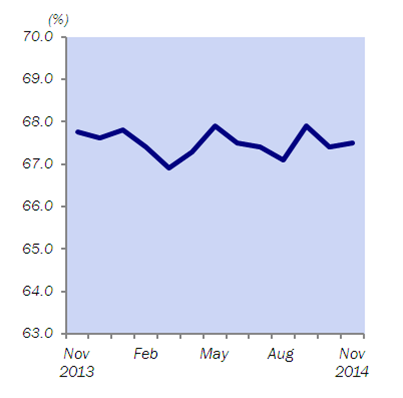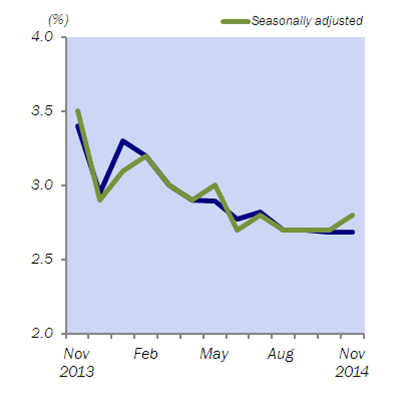Labour Force
- Home
- Statistics
- Labour Market
- Labour Market Information
- Labour Force
Monthly Principal Statistics Of Labour Force, Malaysia, November 2014
Latest Release : 26 January 2015
Upcoming release : 11 February 2026
Overview
| Labour market in Malaysia, November 2014 | Series 66 Vol.01/2015 January 2015 March 2015 |
|
Indicator
|
Previous Month | Same month of the previous year |
||||
|
November
2014
|
October 2014 |
Change % |
November 2013r |
Change
(%)
|
||
|
Labour force (‘000)
|
14,082.9 | 14,080.9 | 0.0 | 13,892.6 | 1.4 | |
|
Employed (‘000)
|
13,707.8 | 13,702.6 | 0.0 | 13,417.0 | 2.2 | |
|
Unemployed (‘000)
|
375.1 | 378.2 | -0.8 | 475.5 | -21.1 | |
|
Outside labour force (‘000)
|
6,777.1 | 6,825.0 | -0.7 | 6,607.6 | 2.6 | |
|
Labour force participation rate (LFPR) (%)
|
67.5 | 67.4 | 0.1 | 67.8 | -0.3 | |
|
Unemployment rate (%)
|
2.7 | 2.7 | - | 3.4 | -0.7 | |
| Seasonally adjusted | ||||||
|
Unemployment rate (%)
|
2.8 | 2.7 | 0.1 | 3.5 | -0.7 | |
 |
A small increase in LFPR by 0.1% The participation in the labour force increased slightly by 0.1 percentage point to 67.5 per cent in November 2014 as compared to 67.4 per cent in the previous month.
Year-on-year comparison showed that the labour force participation rate was lower by 0.3 percentage point than 67.8 per cent in November 2013. |
Notes: · Labour Force Survey (LFS) is conducted to collect information on the structure and distribution of labour force, employment and unemployment.
· The LFS covers both urban and rural areas of all states in Malaysia through the personal interview method. · The survey population is defined to cover persons who live in private living quarters and hence excludes persons residing in institutions such as hotels, hostels, hospitals, prisons, boarding houses and military barracks. · The survey comprises the economically active and inactive population. To measure the economically active population, the LFS uses the age limit of 15 to 64 years. The economically active population comprises those employed and unemployed whereas those who are inactive is classified as outside labour force. · r Revised figures |
|
 |
Unemployment rate remained stable at 2.7% The unemployment rate remained stable at 2.7 per cent. Year on year comparison showed a lower unemployment rate of 0.7 percentage point in November 2013. Meanwhile, the seasonally adjusted unemployment rate was 2.8 per cent, increased by 0.1 percentage point as compared to the percentage in the previous month.
|
TECHNICAL NOTES
This information derived from the Labour Force Survey (LFS) which carried out according to concepts and definitions based from the standard guidelines of International Labour Organizations (ILO) through “Manual on Concepts and Methods of Surveys: Economically Active Population, Employment, Unemployment and Underemployment” which is also used by other country.
The LFS uses the actual status approach, where a person is classified, on the basis of his labour force activity during the reference week.
The LFS uses the actual status approach, where a person is classified, on the basis of his labour force activity during the reference week.
- Labour force refers to those who, during the reference week, are in the 15 to 64 years (in completed years at last birthday) and who are either employed or unemployed;
- Employed refers to all persons who, at any time during the reference week worked at least one hour for pay, profit or family gain (as an employer, employee, own-account worker or unpaid family worker).
Also considered as employed are persons who did not work during the reference week because of illness, injury, disability, bad weather, leave, labour dispute and social or religious reasons but had a job, farm, enterprise or other family enterprise to return to. Also included are those on temporary lay-off with pay who would definitely be called back to work.
Employed persons who had worked less than 30 hours during the reference week because of the nature of their work or due to insufficient work and are able and willing to accept additional hours of work are considered underemployed but are nevertheless included in the “employed” category.
- Unemployed
The unemployed are classified into two that is the actively unemployed and inactively unemployed. The actively unemployed include all persons who did not work during the reference week but were available for work and actively looking for work during the reference week.
Inactively unemployed persons include the following categories:
(a) persons who did not look for work because they believed no work was available or that they were not qualified;
(b) persons who would have looked for work if they had not been temporarily ill or had it not been for bad weather;
(c) persons who were waiting for result of job applications; and
(d) persons who had looked for work prior to the reference week.
(b) persons who would have looked for work if they had not been temporarily ill or had it not been for bad weather;
(c) persons who were waiting for result of job applications; and
(d) persons who had looked for work prior to the reference week.
- The economic activity of a population depends on the demographic characteristics of that population. The proportion of economically active persons, therefore, differs between sub-groups of that population. These variations are measured by specific activity rates termed labour force participation rate. Labour force participation rate is defined as the ratio of the labour force to the working age population (15 to 64 years), expressed as percentage.
- Unemployment rate is the proportion of unemployed population to the total population in labour force. This rate measures the percentage of unemployed population in the labour force.
Seasonally adjusted
Malaysian economic time series data are affected by major religious festivals such as the Eid-ul Fitr, the Chinese New Year and the Deepavali. The major festivals in this country are usually related to the religious activities and such as, the dates are determined by the respective religious calendar. The dates of these holidays are not in line with the Gregorian calendar. Hence, they tend to move along the Gregorian calendar and has strong seasonal influence on many economic time series data.
Since these non-fixed holidays have large impact on the time series data, they need to be taken into account when performing seasonal adjustment process so as to avoid confusion in seasonally adjusted data and trend estimates. Furthermore, the presence of the non-fixed holidays effects may complicate the interpretation of the data.
Seasonal adjustment is a process of removing the estimated effects of normal seasonal variation from the original series so that the effects of other influences on the series may be more clearly recognized.
Seasonal adjustment can be derived by various methods and the results may vary according to the procedure adopted. The approach used for seasonal adjustment in Malaysia is the Seasonal Adjustment for Malaysia (SEAM).
SEAM is a procedure to remove moving holiday effect on the selected Malaysian economic time series data by introducing steps that can be used to overcome the limitations of the existing seasonal adjustment procedure. To apply the SEAM procedure, the X-ARIMA program which is available in Statistical Analysis Software (SAS) is used.
This seasonal adjusted rate will be revised when a complete 12 months time series for the particular year are obtained.
Indicator of seasonal adjustment is being published for the first time starting on January 2012 for comparison with actual data.
Released By:
THE OFFICE OF CHIEF STATISTICIAN MALAYSIA
DEPARTMENT OF STATISTICS, MALAYSIA
26 January 2015
Contact person:
Norrita binti Amran
Public Relation Officer
Corporate and User Services Division
Department of Statistics, Malaysia
Tel : +603-8885 7942
Fax : +603-8888 9248
Email : norrita.amran@stats.gov.my
Subscribe
Newsletter
Subscribe to our newsletter and stay updated
For interviews, press statement and clarification to the media, contact:
Baharudin Mohamad
Public Relation Officer
Email: baharudin[at]dosm.gov.my
Phone: 03 8090 4681
Not found what you looking for? Request data from us, through
Go to eStatistik
Email: data[at]dosm.gov.my
Phone: 03 8885 7128 (data request)










